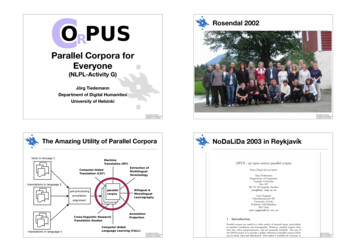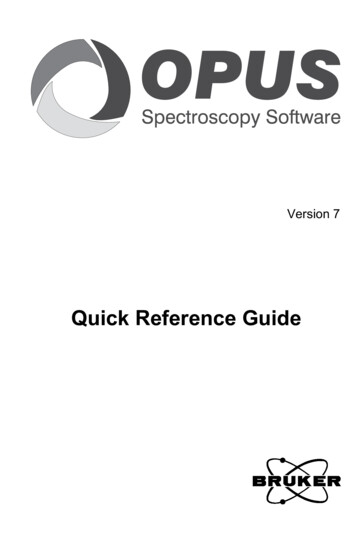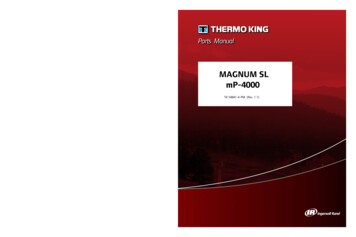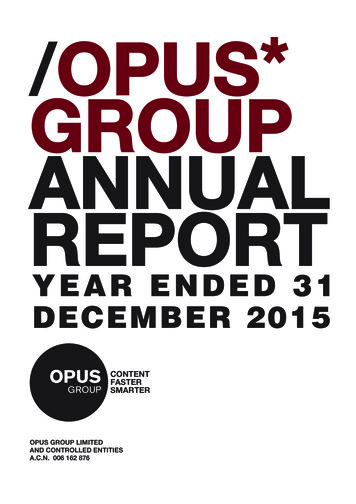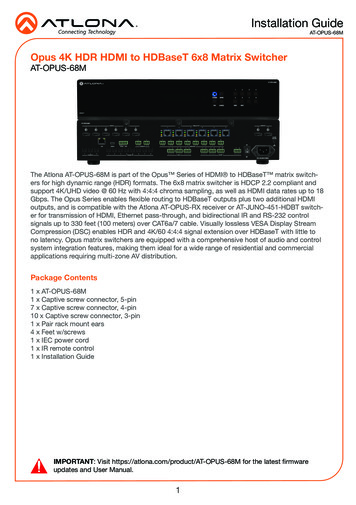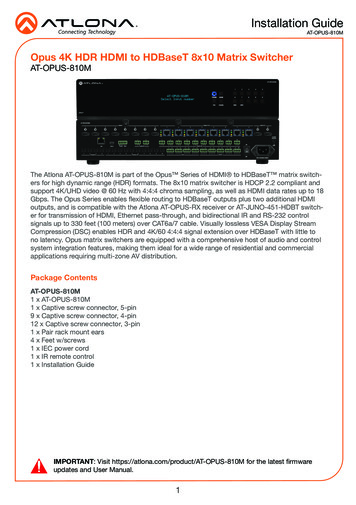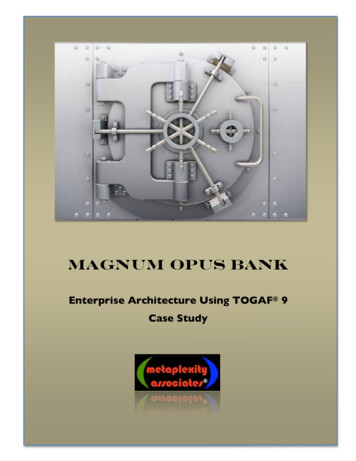
Transcription
Magnum Opus BankEnterprise Architecture Using TOGAF 9Case Study
Magnum Opus Bank - Case Study 2011 Metaplexity Associates LLC – All Rights ReservedVersion 1.3January 2, 2011TMTOGAF 9Accredited Training CourseThe Open Group Certification logo is a trademark and the word TOGAF is a registeredtrademark of The Open Group in the United States and other countries.Enterprise Architecture Using TOGAF 9 v1.3 is an Accredited TOGAF 9 TrainingCourse and complies with the accreditation requirements for The Open Group TOGAFCertification for People program.metaplexity associates llc8400 Normandale Lake Blvd. Suite 920Bloomington, MN 55437www.metaplexity.com 1 952 820 44402Foundations of Enterprise Architecture Using TOGAF 9 2011 Metaplexity Associates LLC – All Rights Reserved
Magnum Opus Bank - Case StudyMagnum Opus BankBackgroundIt had been a long day for Wallace Humphrey III, Chairman and Chief Executive Officerof Magnum Opus Bank. His brief tenure as CEO had been challenging from thebeginning. Hired just six months ago after the board had dismissed the previousleadership team, he was determined to turn Magnum Opus Bank around.He had already begun an aggressive campaign to evaluate the 2,350 retail bankingfacilities and close those that were not generating high enough profits to meet theboard’s criteria for Return on Capital Employed.Other measures were being implemented to improve overall operational efficiency, andreduce expenditures.However, Wallace knew that he could not grow the firm through cost reductions andoperational efficiency improvements. Improving the overall revenue growth of the firmwas going to mean focusing on more lucrative segments of the market. Instead of tryingto be all things to all people, Magnum Opus Bank needed to focus on the needs of theright customers.Recent market studies had clearly indicated that Magnum Opus Bank was not the bankof choice for the high net worth clients in the bank’s market areas. The researchindicated that a large number of high value clients were transferring their assets toCogswell Trust Bank where a thriving private banking operation was eager to meet theirspecial needs.To hold on to the existing high value clients and grow additional relationships wouldtake some significant changes.An internal study of the bank’s Investment Banking and Brokerage operations revealedthat the average settlement time on investment transactions was several days higherthan the competition. This was a source of concern among the banks wealthiestcustomers. Clearly, this was an area that was in need of improvement if there was goingto be a turnaround at Magnum Opus Bank.To make matters worse, the Private Bank had an antiquated Customer Service Systemthat did a splendid job of displaying current account balances and address informationabout the client, but precious little else. What was needed was the ability for a bankerto have a comprehensive view of the relationship with the client, to identify key issues intheir portfolio, and to identify where other bank services might be a good fit for theclient.This is a fictitious case study intended for instructional purposes only. Any similaritybetween the individuals and organizations described in this case with actual individualsor organizations is entirely coincidental.Foundations of Enterprise Architecture Using TOGAF 9 2011 Metaplexity Associates LLC– All Rights Reserved3
Magnum Opus Bank - Case StudyMagnum Opus Bank MarketAs illustrated in Figure 1, Magnum Opus Bank operates in the eastern half of thecontinental United States. It does not include the northern states of Vermont, Maine,and New Hampshire. Its primary market is in Connecticut where it is the leading retailbank.Figure 1 Magnum Opus Bank Market AreaIt operates a network of retail banks in the larger metropolitan areas in each of thestates in which it operates. Typically, only communities with populations greater than200,000 people will have retail bank presence. Smaller communities are served throughAutomated Teller Machines.The bank operates an online banking site that handles a broad range of activities frompersonal banking, business banking, home mortgage, and investment banking andbrokerage services. Each of these entities is tied to the related business units.4Foundations of Enterprise Architecture Using TOGAF 9 2011 Metaplexity Associates LLC – All Rights Reserved
Magnum Opus Bank - Case Study!"# %&'(&)*% , %%&-. "&!"# %&'()*"' ),#- -"'./0"1#*"/#'2 /3%/-'4)/15*",'6"/7%/-'Figure 2 - Operations by Percent of SalesMagnum Opus FinancialsMagnum Opus Bank has operations in 28 states with a total of 2,350 retail banklocations and 830 Home Mortgage centers. It currently manages 400 billion in assets.In its most recent fiscal year it posted a net operating loss of 150,000,000 on grosssales of 40 billion. The previous year’s sales were 41 billion with a net operating lossof 52,000,000.Its current market capitalization is valued at 35 billion, down 15% from the previousyear.Magnum Opus Bank OperationsMagnum Opus Bank employs 90,000 people. Approximately 8,500 of those employeesare located at the firm’s headquarters in Stamford, CT. The remaining employees aredistributed across the retail banking operations.!"# %&'()%*' " ,'-'. /01&"230 '4567 080#9'A key part of the operations of the bank is Information Technology. The InformationTechnology Division employs 3500 full time employees and it also maintains anoutsourced IT operation in Bangalore with 1,000 developers and 250 call center staff.The Information Technology Division is led by Chief Information Officer, Dave Quimby,the Senior Vice President for Information Technology. He reports to the ChiefFinancial Officer, Annette Franklin.Foundations of Enterprise Architecture Using TOGAF 9 2011 Metaplexity Associates LLC– All Rights Reserved5
Magnum Opus Bank - Case Study4.8'.9'?#"",%/-'4)**%#""'498':;'; 8':;'8 ", #%)/1':;'?5 ),#':;' 2'2 /- &),"'Figure 3 - IT Division Organization ChartThe bank operates two data centers. One is located in Stamford CT, and the other islocated in Alexandria VA. A third data center in Charlotte NC is scheduled to open inthe coming fiscal year.Currently, there are 3,250 applications supported by the ITD. Of those, the majority ofthe financial systems are operated on IBM Z Series systems in a Parallel Sysplexconfiguration. Backend applications are largely best of breed applications that weredeveloped in COBOL and Assembler in the 1970s. There is a movement towardutilizing WebSphere as a replacement platform for the legacy applications. However,the bank has also begun evaluating solutions from the major ERP vendors.The desktop environment consists of 110,000 laptops and desktops. Most of thedesktops are still running Windows XP. Nearly all of the investment bankers, traders,and brokers have been upgraded to Windows 7, however, some 250 of the desktops inthe Investment Bank are running OS/2 due to legacy application constraints. About 180marketing and advertising staff utilize Macintosh computers running MacOSX for mediaproduction. The trading area has a very unstable mix of systems that are utilized andmanaged by the traders to track information services and execute trading transactions.There are 2,450 registered departmental servers, most of which are running Windows2000. The online banking systems are hosted on Linux servers running Apache, MySQL,and JBoss.Most of the development work is actually done in Bangalore. The IT departmentdesigns the systems in house and then sends the work requests to the Indiandevelopment group.6Foundations of Enterprise Architecture Using TOGAF 9 2011 Metaplexity Associates LLC – All Rights Reserved
Magnum Opus Bank - Case Study. /01&"230 '4567 080#9':3;3*30 '-'' **5**&5 2' 5)012'After the recent leadership change, a consultant was engaged to assess how theInformation Technology Division could address the serious challenges it faces. Theconsultant’s exit report called for the implementation of a broad EnterpriseArchitecture initiative that would be sponsored by the CTO with close ties to the PMO.The Enterprise Architecture group should be focused on the needs of the business. AllEA activities should be linked to demonstrable business objectives. To the extentpossible, all EA activities should be self-funding based on demonstrated revenueenhancement or cost savings.In addition the consultant made the following observations: There is no discernable technology portfolio management in placeIT spending decisions are largely made by individual business unitsThere are few defined corporate standards for IT beyond certain desktopsoftware standards and networking standardsThe lack of effective configuration management raises serious compliance issuesThere is no coordination of development methods or lifecycles acrossorganizational unitsIT governance is in place, but not well implemented or enforcedThe priorities of IT management are not aligned with the needs of the businessThe Presentation to the BoardMr. Humphrey knew he had to make some hard choices. What combination ofstrategies would yield the desired results? How could he emphasize a focus on his bestcustomers when there were insufficient resources to do the on-going maintenance ofthe IT plant within the current budget? What should he do about the consultant’sreport? There were some good ideas; as a matter of fact they were all good. Howwould he implement them?Mr. Humphrey sat down at his desk and opened up his laptop to begin writing hispresentation for the board’s quarterly meeting. He knew that if he didn’t recommendsome very serious change initiatives, he might not have to prepare any future reports tothis board.Foundations of Enterprise Architecture Using TOGAF 9 2011 Metaplexity Associates LLC– All Rights Reserved7
Magnum Opus Bank - Case Study8Foundations of Enterprise Architecture Using TOGAF 9 2011 Metaplexity Associates LLC – All Rights Reserved
Magnum Opus Bank Market As illustrated in Figure 1, Magnum Opus Bank operates in the eastern half of the continental United States. It does not include the northern states of Vermont, Maine, and New Hampshire. Its primary market is in Connecticut where it is the leading retail bank. Figure 1 Magnum Opus Bank Market Area
